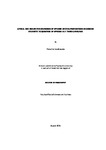Literal and figurative meanings of Spanish spatial prepositions in Chinese students’ acquisition of Spanish as a third language
| dc.contributor.supervisor | Guijarro Fuentes, Pedro | |
| dc.contributor.author | Encinas Arquero, Pablo | |
| dc.contributor.other | Faculty of Arts, Humanities and Business | en_US |
| dc.date.accessioned | 2016-06-09T12:29:25Z | |
| dc.date.available | 2016-06-09T12:29:25Z | |
| dc.date.issued | 2016 | |
| dc.identifier | 10132769 | en_US |
| dc.identifier.uri | http://hdl.handle.net/10026.1/4873 | |
| dc.description.abstract |
This thesis investigates the acquisition of the spatial and figurative meanings of five Spanish spatial particles, namely sobre, encima, debajo, bajo and en, by a group of Chinese university students of Spanish as a foreign language at intermediate and upper-intermediate language levels. More specifically, this study aims to answer two questions. The first question considers the order of acquisition of prepositional meanings, that is, whether this is similar to a native language, with literal and more primary meanings acquired first and figurative ones later or, conversely, whether the pattern of acquisition is different to that found in a first language (Kemmerer, 2005; Lam, 2010). The second question of this research is to determine whether there are observable differences between the degree of acquisition and use of these prepositions in English compared to Spanish, and if so, what the characteristics of these differences are. To try to answer these questions, the performance of this group of participants in four behavioural tests is compared. The tests were a lexical identification task, a picture fill-in-the- blank task, a sentence generation task and a truth value judgment task. These tests were conducted both in Spanish, which the participants had begun to study at undergraduate level and English, which they had first been exposed to in school in a pre-puberty period. The results of this study indicate, first, that the acquisition of the literal and figurative meanings of the spatial particles in this study does not follow a pattern similar to that found in a native language. That is, meaning acquisition in a foreign language occurs in a parallel or simultaneous pattern. Furthermore, in a non-immersion context such as that of this study, the age at which students begin the study of a foreign language is not a decisive factor in determining the degree of mastery that students can obtain. The quantity and quality of the input students are exposed to; together with an appropriate methodology appear to be the most important factors in predicting the level of proficiency that can be reached. | en_US |
| dc.language.iso | en | en_US |
| dc.publisher | Plymouth University | en_US |
| dc.subject | Second language acquisition | en_US |
| dc.subject | Chinese | |
| dc.subject | English | |
| dc.subject | Spanish prepositions | |
| dc.subject | Spanish prepositions | |
| dc.title | Literal and figurative meanings of Spanish spatial prepositions in Chinese students’ acquisition of Spanish as a third language | en_US |
| dc.type | Thesis | |
| plymouth.version | Full version | en_US |
| dc.identifier.doi | http://dx.doi.org/10.24382/3966 | |
| dc.identifier.doi | http://dx.doi.org/10.24382/3966 |
Files in this item
This item appears in the following Collection(s)
-
01 Research Theses Main Collection
Research Theses Main


